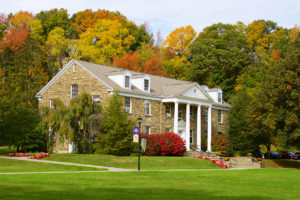When it comes to student retention rates, Houghton is choosing to focus less on the numbers and more on how many students choose to return to campus.
“Percentage of students withdrawing has gone up, but you have to check that in relation to enrollment” noted Rob Pool, Vice President of Student Life. According to the data distribution site College Factual, Houghton College has freshman retention rates above the national average of 71.2%. In February, Houghton reported its retention rate for 2017 at a little over 86%, 15% higher than the national average. While this does still show a slight dip from the numbers reported for the period between 2012 to 2015, which ranged from 87-88%, this metric is up from 86 percent in the 2016 academic year.
 Pool’s focus, however, has fixed on examining how Houghton kept students coming back. “We had a pretty good rift last semester,” explained Pool at a recent SGA discussion forum on current retention rates. “We had a lot of students who were concerned about how the college was responding to, developing, supporting all of our students, certainly our students from underrepresented populations. How are we helping those students navigate, find support, feel integrated into the entire student population, and welcomed? These are questions that we’ve been working with pretty intensely since last spring.”
Pool’s focus, however, has fixed on examining how Houghton kept students coming back. “We had a pretty good rift last semester,” explained Pool at a recent SGA discussion forum on current retention rates. “We had a lot of students who were concerned about how the college was responding to, developing, supporting all of our students, certainly our students from underrepresented populations. How are we helping those students navigate, find support, feel integrated into the entire student population, and welcomed? These are questions that we’ve been working with pretty intensely since last spring.”
Last semester, Houghton began considering changes that, according to Pool, were “much more programmatically based. How are we allocating our resources? How are we shaping our policy? What do we need to be doing to make all of our students, especially students of color, feel more welcome?”
One of the answers was renovating the basement of the campus center to include an intercultural campus center. “You’ll see programming down there. You’ll see a rotation of faculty and staff holding office hours in that space,” explained Pool. “It’ll be decorated differently—we’ll actually have furniture that people can lounge it. Student organizations can have some meetings, do some planning, even some programming down there with small discussion groups.”
Outside of the events that student groups will be able to host in the new space, administration already has plans for special programming to celebrate the upcoming Martin Luther King Jr. Day. There will be no classes, but a full day’s worth of activities, speakers, and possibly social events will be incorporated.
Institutional policies will also undergo adjustments in the hopes of establishing a more welcoming campus environment. “The college is in the process of approving and adopting a new diversity statement,” said Pool. “We actually haven’t articulated yet what we want mean by diversity, what we want to include in that statement, and how we want to come together as a community around that. So a pretty substantial diversity statement has been drafted. Right now it’s in the Student Life Council. Then it’ll go to the Student Government and the faculty on to the Board of Trustees this year.”
Pool said he often hears students asking, “Why is it so important? Why it so important that we have program space, faculty, staff, trainings?” In reply, he answered that issues of acceptance become “a compounding problem for our students from diverse backgrounds when we have a lack of faculty or staff who have innate common experiences and who have the life experience to provide and some council.” He mentions that the administration’s newest initiative is to attract and retain faculty from a diverse background, despite the challenges of finding candidates for a position in s rural an area.
College Factual reportsed that the median cost to recruit a student is “$2,433 for private colleges and $457 for public colleges.” Each time Houghton loses a student, the college loses its return on investment simply because of the amount spent on recruiting them.
Another consequence of frequent dropouts is the affect it has on a school’s graduation rates and, subsequently, funding. Despite the percentage of students who do not remain past their first year, the College Factual report confirmed that “Both the on-time (two or four years depending on the degree) graduation rate of 66.0% and the overall rate of 72.7% rank Houghton College among the best in the country.” The majority of students who do not graduate chose to drop out.
Compared to expected national trends, students at Houghton “are graduating at a rate that is 15.3% higher. Therefore, Houghton College is among the highest performing schools nationwide in graduating students when their anticipated academic achievement is factored in.”
In recent months, Houghton has reported recognition already received from outside organizations. “Houghton College was recently ranked as having the fifth-best freshman retention rate for rural, four-year private nonprofit institutions, according to the Chronicle for Higher Education,” the college announced. Additionally, “Of the 118 member schools of the Council for Christian Colleges and Universities (CCCU), Houghton ranked first among the 10 rural institutions included.”
